Limb Sounders Tracking Tsunami-Induced Perturbations from the Stratosphere to the Ionosphere
Abstract
1. Introduction
2. Data and Methodology
2.1. F3/C LEO-Based GNSS Data
2.2. SABER Measurements
2.3. Method
3. Results
3.1. The Vertical Perturbations Detected from the Stratosphere to the Ionosphere
3.2. The Tsunami-Induced Gravity Wavefront in the Ionosphere Detected by the RO Sounder
4. Discussion
4.1. Dependence of Vertical Wavelength on Height and Time
4.2. The “Early” Perturbations before the 2015 Tsunami Wave Packet
5. Conclusions
Supplementary Materials
Author Contributions
Funding
Data Availability Statement
Acknowledgments
Conflicts of Interest
References
- Yuen, P.C.; Weaver, P.F.; Suzuki, R.K.; Furumoto, A.S. Continuous, traveling coupling between seismic waves and the ionosphere evident in May 1968 Japan earthquake data. J. Geophys. Res. 1969, 74, 2256–2264. [Google Scholar] [CrossRef]
- Davies, K. Ionospheric Radio; Peter Peregrinus Ltd.: London, UK, 1990; ISBN 64 60061. [Google Scholar]
- Liu, J.Y.; Chen, C.H.; Sun, Y.Y.; Chen, C.H.; Tsai, H.F.; Yen, H.Y.; Chum, J.; Lastovicka, J.; Yang, Q.S.; Chen, W.S.; et al. The vertical propagation of disturbances triggered by seismic waves of the 11 March 2011 M9.0 Tohoku earthquake over Taiwan. Geophys. Res. Lett. 2016, 43, 1759–1765. [Google Scholar] [CrossRef]
- Calais, E.; Minster, J.B. GPS detection of ionospheric perturbations following the January 17, 1994, Northridge Earthquake. Geophys. Res. Lett. 1995, 22, 1045–1048. [Google Scholar] [CrossRef]
- Heki, K.; Ping, J. Directivity and apparent velocity of the coseismic ionospheric disturbances observed with a dense GPS array. Earth Planets Sci. Lett. 2005, 236, 845–855. [Google Scholar] [CrossRef]
- Galvan, D.A.; Komjathy, A.; Hickey, M.P.; Stephens, P.; Snively, J.; Tony Song, Y.; Butala, M.D.; Mannucci, A.J. Ionospheric signatures of Tohoku-Oki tsunami of March 11, 2011: Model comparisons near the epicenter. Radio Sci. 2012, 47, 1–10. [Google Scholar] [CrossRef]
- Jin, S.; Jin, R.; Li, J.H. Pattern and evolution of seismo-ionospheric disturbances following the 2011 Tohoku earthquakes from GPS observations. J. Geophys. Res. Space Phys. 2014, 119, 7914–7927. [Google Scholar] [CrossRef]
- Liu, Y.; Jin, S. Ionospheric Rayleigh Wave Disturbances Following the 2018 Alaska Earthquake from GPS Observations. Remote Sens. 2019, 11, 901. [Google Scholar] [CrossRef]
- Makela, J.J.; Lognonné, P.; Hébert, H.; Gehrels, T.; Rolland, L.; Allgeyer, S.; Kherani, A.; Occhipinti, G.; Astafyeva, E.; Cosson, P.; et al. Imaging and modeling the ionospheric airglow response over Hawaii to the tsunami generated by the Tohoku earthquake of 11 March 2011. Geophys. Res. Lett. 2011, 38, 117. [Google Scholar] [CrossRef]
- Smith, S.M.; Martinis, C.R.; Baumgardner, J.; Mendillo, M. All-sky imaging of transglobal thermospheric gravity waves generated by the March 2011 Tohoku Earthquake. J. Geophys. Res. A Sp. Phys. 2015, 120, 10992–10999. [Google Scholar] [CrossRef]
- Utada, H.; Shimizu, H.; Ogawa, T.; Maeda, T.; Furumura, T.; Yamamoto, T.; Yamazaki, N.; Yoshitake, Y.; Nagamachi, S. Geomagnetic field changes in response to the 2011 off the Pacific Coast of Tohoku Earthquake and Tsunami. Earth Planets Sci. Lett. 2011, 311, 11–27. [Google Scholar] [CrossRef]
- Hao, Y.Q.; Xiao, Z.; Zhang, D.H. Multi-instrument observation on co-seismic ionospheric effects after great Tohoku earthquake. J. Geophys. Res. Space Phys. 2012, 117, 1–8. [Google Scholar] [CrossRef]
- Garcia, R.F.; Bruinsma, S.; Lognonné, P.; Doornbos, E.; Cachoux, F. GOCE: The first seismometer in orbit around the Earth. Geophys. Res. Lett. 2013, 40, 1015–1020. [Google Scholar] [CrossRef]
- Garcia, R.F.; Doornbos, E.; Bruinsma, S.; Hebert, H. Atmospheric gravity waves due to the Tohoku-Oki tsunami observed in the thermosphere by GOCE. J. Geophys. Res. 2014, 119, 4498–4506. [Google Scholar] [CrossRef]
- Yang, Y.M.; Meng, X.; Komjathy, A.; Verkholyadova, O.; Langley, R.B.; Tsurutani, B.T.; Mannucci, A.J. Tohoku-Oki earthquake caused major ionospheric disturbances at 450 km altitude over Alaska. Radio Sci. 2014, 49, 1206–1213. [Google Scholar] [CrossRef]
- Occhipinti, G. The Seismology of the Planet Mongo: The 2015 Ionospheric Seismology Review. In Subduction Dyn. Mantle Flow Mega Disasters, Geophysical Monograph 211, 1st ed.; American Geophysical Union (AGU): Washington, DC, USA, 2015; pp. 169–182. [Google Scholar]
- Lognonné, P.; Clévédé, E.; Kanamori, H. Computation of seismograms and atmospheric oscillations by normal-mode summation for a spherical earth model with realistic atmosphere. Geophys. J. Int. 1998, 135, 388–406. [Google Scholar] [CrossRef]
- Chen, C.H.; Saito, A.; Lin, C.H.; Liu, J.Y.; Tsai, H.F.; Tsugawa, T.; Otsuka, Y.; Nishioka, M.; Matsumura, M. Long-distance propagation of ionospheric disturbance generated by the 2011 off the Pacific coast of Tohoku Earthquake. Earth Planets Space 2011, 63, 881–884. [Google Scholar] [CrossRef]
- Liu, J.Y.; Chen, C.H.; Lin, C.H.; Tsai, H.F.; Chen, C.H.; Kamogawa, M. Ionospheric disturbances triggered by the 11 March 2011 M9.0 Tohoku earthquake. J. Geophys. Res. Space Phys. 2011, 116, 1–5. [Google Scholar]
- Rolland, L.M.; Lognonné, P.; Astafyeva, E.; Kherani, E.A.; Kobayashi, N.; Mann, M.; Munekane, H. The resonant response of the ionosphere imaged after the 2011 off the Pacific coast of Tohoku Earthquake. Earth Planets Space 2011, 63, 853–857. [Google Scholar] [CrossRef]
- Tsai, H.-F.; Liu, J.-Y.; Lin, C.-H.; Chen, C.-H. Tracking the epicenter and the tsunami origin with GPS ionosphere observation. Earth Planets Space 2011, 63, 859–862. [Google Scholar] [CrossRef]
- Tsugawa, T.; Saito, A.; Otsuka, Y.; Nishioka, M.; Maruyama, T.; Kato, H.; Nagatsuma, T.; Murata, K. Ionospheric disturbances detected by GPS total electron content observation after the 2011 off the Pacific coast of Tohoku Earthquake. Earth Planets Space 2011, 63, 875–879. [Google Scholar] [CrossRef]
- Occhipinti, G.; Rolland, L.; Lognonné, P.; Watada, S. From Sumatra 2004 to Tohoku-Oki 2011: The systematic GPS detection of the ionospheric signature induced by tsunamigenic earthquakes. J. Geophys. Res. Space Phys. 2013, 118, 3626–3636. [Google Scholar] [CrossRef]
- Kamogawa, M.; Orihara, Y.; Tsurudome, C.; Tomida, Y.; Kanaya, T.; Ikeda, D.; Gusman, A.R.; Kakinami, Y.; Liu, J.Y.; Toyoda, A. A possible space-based tsunami early warning system using observations of the tsunami ionospheric hole. Sci. Rep. 2016, 6, 37989. [Google Scholar] [CrossRef] [PubMed]
- Grawe, M.A.; Makela, J.J. Observation of tsunami-generatedionospheric signatures over Hawaiicaused by the 16 September 2015 Illapel earthquake. J. Geophys. Res. Space Phys. 2017, 122, 1128–1136. [Google Scholar] [CrossRef]
- Chou, M.-Y.; Cherniak, I.; Lin, C.C.; Pedatella, N.M. The persistent ionospheric responses over Japan after the impact of the 2011 Tohoku earthquake. Space Weather 2000, 18, e2019SW002302. [Google Scholar] [CrossRef]
- Chou, M.-Y.; Yue, J.; Lin, C.C.; Rajesh, P.K.; Pedatella, N.M. Conjugate effect of the 2011 Tohoku reflected tsunami-driven gravity waves in the ionosphere. Geophys. Res. Lett. 2022, 49, e2021GL097170. [Google Scholar] [CrossRef]
- Coïsson, P.; Lognonné, P.; Walwer, D.; Rolland, L.M. First tsunami gravity wave detection in ionospheric radio occultation data. Earth Sp. Sci. 2015, 2, 125–133. [Google Scholar] [CrossRef]
- Liu, J.-Y.; Chen, C.-Y.; Sun, Y.-Y.; Lee, I.-T.; Chum, J. Fluctuations on vertical profiles of the ionospheric electron density perturbed by the March 11, 2011 M9.0 Tohoku earthquake and tsunami. GPS Solut. 2019, 23, 76. [Google Scholar] [CrossRef]
- Yan, X.; Sun, Y.; Yu, T.; Liu, J.Y.; Qi, Y.; Xia, C.; Zuo, X.; Yang, N. Stratosphere Perturbed by the 2011 Mw9.0 Tohoku Earthquake. Geophys. Res. Lett. 2018, 45, 10050–10056. [Google Scholar] [CrossRef]
- Alexander, P.; de la Torre, A.; Schmidt, T.; Llamedo, P.; Hierro, R. Limb sounders tracking topographic gravity wave activity from the stratosphere to the ionosphere around midlatitude Andes. J. Geophys. Res. Space Phys. 2015, 120, 9014–9022. [Google Scholar] [CrossRef]
- Yang, Y.M.; Verkhoglyadova, O.; Mlynczak, M.G.; Mannucci, A.J.; Meng, X.; Langley, R.B.; Hunt, L.A. Satellite-based observations of tsunami-induced mesosphere airglow perturbations. Geophys. Res. Lett. 2017, 44, 522–532. [Google Scholar] [CrossRef]
- Astafyeva, E. Ionospheric detection of natural hazards. Rev. Geophys. 2019, 57, 1265–1288. [Google Scholar] [CrossRef]
- Occhipinti, G.; Lognonné, P.; Kherani, E.A.; Hébert, H. Three-dimensional waveform modeling of ionospheric signature induced by the 2004 Sumatra tsunami. Geophys. Res. Lett. 2006, 33, L20104. [Google Scholar] [CrossRef]
- Occhipinti, G.; Kherani, A.; Lognonné, P. Geomagnetic dependence of ionospheric disturbances induced by tsunamigenic internal gravity waves. Geophys. J. Int. 2008, 173, 753–765. [Google Scholar] [CrossRef]
- Kherani, E.A.; Lognonné, P.; Kamath, N.; Crespon, F.; Garcia, R. Response of the ionosphere to the seismic triggered acoustic waves: Electron density and electromagnetic fluctuations. Geophys. J. Int. 2009, 176, 1–13. [Google Scholar] [CrossRef]
- Yue, X.; Schreiner, W.S.; Hunt, D.C.; Rocken, C.; Kuo, Y.H. Quantitative evaluation of the low Earth orbit satellite based slant total electron content determination. Sp. Weather 2011, 9, S09001. [Google Scholar] [CrossRef]
- Anthes, R.A.; Bernhardt, P.A.; Chen, Y.; Cucurull, L.; Dymond, K.F.; Ector, D.; Healy, S.B.; Ho, S.P.; Hunt, D.C.; Kuo, Y.H.; et al. The COSMIC/Formosat-3 mission: Early results. Bull. Am. Meteorol. Soc. 2008, 89, 313–333. [Google Scholar] [CrossRef]
- Das, U.; Pan, C.J. Validation of FORMOSAT-3/COSMIC level 2 "atmPrf" global temperature data in the stratosphere. Atmos. Meas. Tech. 2014, 7, 731–742. [Google Scholar] [CrossRef]
- Alexander, P.; de la Torre, A.; Llamedo, P. Interpretation of gravity wave signatures in GPS radio occultations. J. Geophys. Res. Atmos. 2008, 113, 27. [Google Scholar] [CrossRef]
- Faber, A.; Llamedo, P.; Schmidt, T.; De La Torre, A.; Wickert, J. On the determination of gravity wave momentum flux from GPS radio occultation data. Atmos. Meas. Tech. 2013, 6, 3169–3180. [Google Scholar] [CrossRef]
- Kursinski, E.R.; Hajj, G.A.; Leroy, S.S.; Herman, B. The GPS radio occultation technique. Terr. Atmos. Ocean. Sci. 2000, 11, 53–114. [Google Scholar] [CrossRef]
- Sokolovskiy, S.; Rocken, C.; Schreiner, W.; Hunt, D. On the uncertainty of radio occultation inversions in the lower troposphere. J. Geophys. Res. Atmos. 2010, 115, 56. [Google Scholar] [CrossRef]
- Hocke, K.; Tsuda, T. Gravity waves and ionospheric irregularities over tropical convection zones observed by GPS/MET radio occultation. Geophys. Res. Lett. 2001, 28, 2815–2818. [Google Scholar] [CrossRef]
- Mlynczak, M.G. Energetics of the mesosphere and lower thermosphere and the SABER experiment. Adv. Space Res. 1997, 20, 1177–1183. [Google Scholar] [CrossRef]
- Savitzky, A.; Golay, M.J.E. Smoothing and Differentiation of Data by Simplified Least Squares Procedures. Anal. Chem. 1964, 36, 1627–1639. [Google Scholar] [CrossRef]
- John, S.R.; Kumar, K.K. TIMED/SABER observations of global gravity wave climatology and their interannual variability from stratosphere to mesosphere lower thermosphere. Clim. Dyn. 2012, 39, 1489–1505. [Google Scholar] [CrossRef]
- Torrence, C.; Compo, G.P. A Practical Guide to Wavelet Analysis. Bull. Am. Meteorol. Soc. 1998, 79, 61–78. [Google Scholar] [CrossRef]
- Yasyukevich, Y.V.; Kiselev, A.V.; Zhivetiev, I.V.; Edemskiy, I.K.; Syrovatskiy, S.V.; Maletckii, B.M.; Vesnin, A.M. SIMuRG: System for Ionosphere Monitoring and Research from GNSS. GPS Solut. 2020, 24, 69. [Google Scholar] [CrossRef]
- Vadas, S.L. Horizontal and vertical propagation and dissipation of gravity waves in the thermosphere from lower atmospheric and thermospheric sources. J. Geophys. Res. 2007, 112, A06305. [Google Scholar] [CrossRef]
- Yue, J.; Hoffmann, L.; Joan Alexander, M. Simultaneous observations of convective gravity waves from a ground-based airglow imager and the AIRS satellite experiment. J. Geophys. Res. Atmos. 2013, 118, 3178–3191. [Google Scholar] [CrossRef]
- Astafyeva, E.; Lognonné, P.; Rolland, L. First ionospheric images of the seismic fault slip on the example of the Tohoku-oki earthquake. Geophys. Res. Lett. 2011, 38, 1–6. [Google Scholar] [CrossRef]
- Kherani, E.A.; Abdu, M.A.; Fritts, D.C.; de Paula, E.R. The Acoustic Gravity Wave Induced Disturbances in the Equatorial Ionosphere. In Aeronomy of the Earth’s Atmosphere and Ionosphere; IAGA Special Sopron Book Series; Springer: Dordrecht, The Netherlands, 2013; Volume 2, pp. 141–162. [Google Scholar] [CrossRef]
- Vadas, S.L.; Makela, J.J.; Nicolls, M.J.; Milliff, R.F. Excitation of gravity waves by ocean surface wave packets: Upward propagation and reconstruction of the thermospheric gravity wave field. J. Geophys. Res. Space Phys. 2015, 120, 9748–9780. [Google Scholar] [CrossRef]
- Liu, J.Y.; Lin, C.Y.; Tsai, Y.L.; Liu, T.C.; Hattori, K.; Sun, Y.Y.; Wu, T.R. Ionospheric GNSS Total Electron Content for Tsunami Warning. J. Earthq. Tsunami 2019, 13, 1941007. [Google Scholar] [CrossRef]
- Occhipinti, G.; Coïsson, P.; Makela, J.J.; Allgeyer, S.; Kherani, A.; Hébert, H.; Lognonné, P. Three-dimensional numerical modeling of tsunami-related internal gravity waves in the Hawaiian atmosphere. Earth Planets Space 2011, 63, 847–851. [Google Scholar] [CrossRef]
- Klobuchar, J.A. Ionospheric Time-Delay Algorithm for Single-Frequency GPS Users. IEEE Trans. Aerosp. Electron. Syst. 1987, AES-23, 325–331. [Google Scholar] [CrossRef]
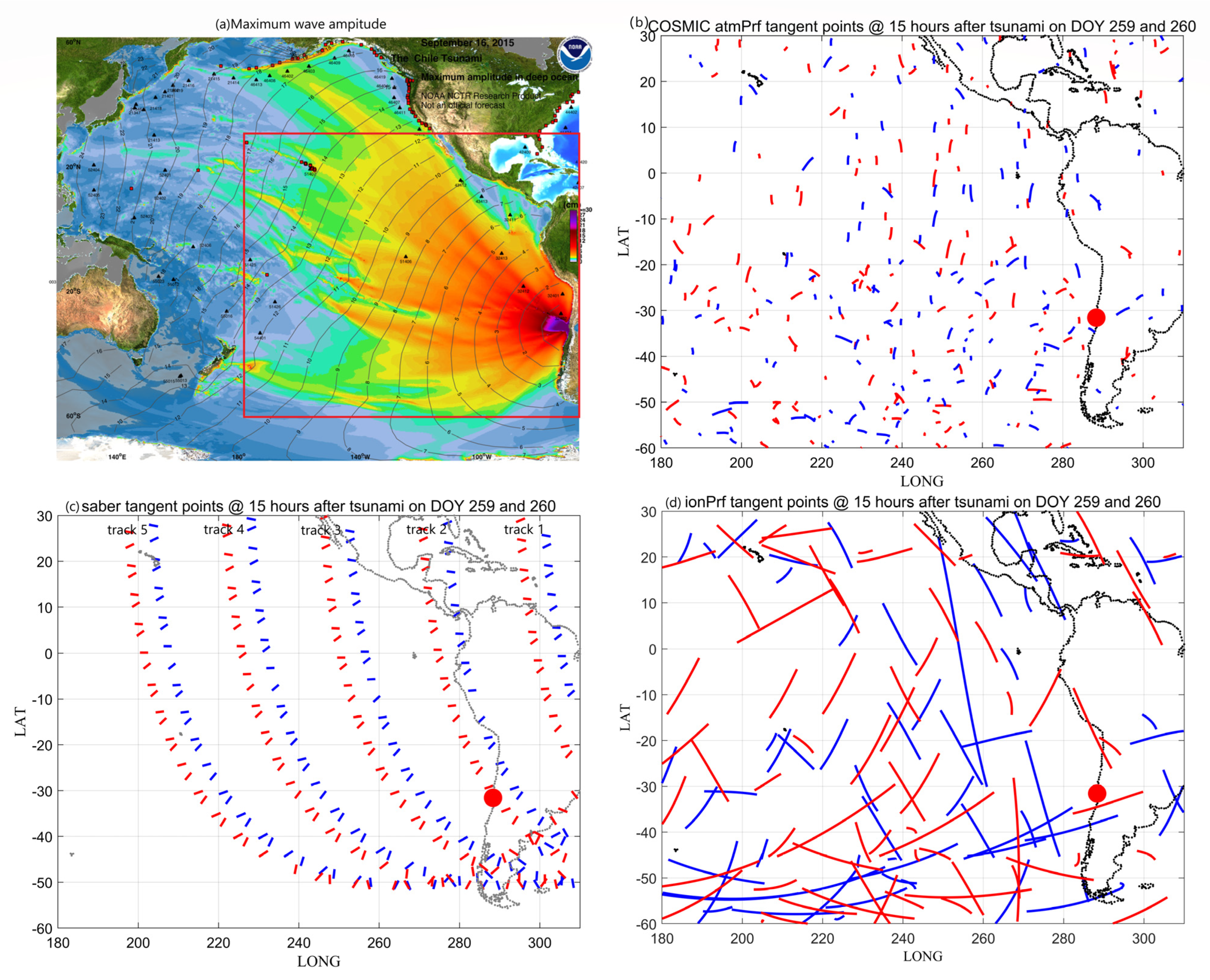
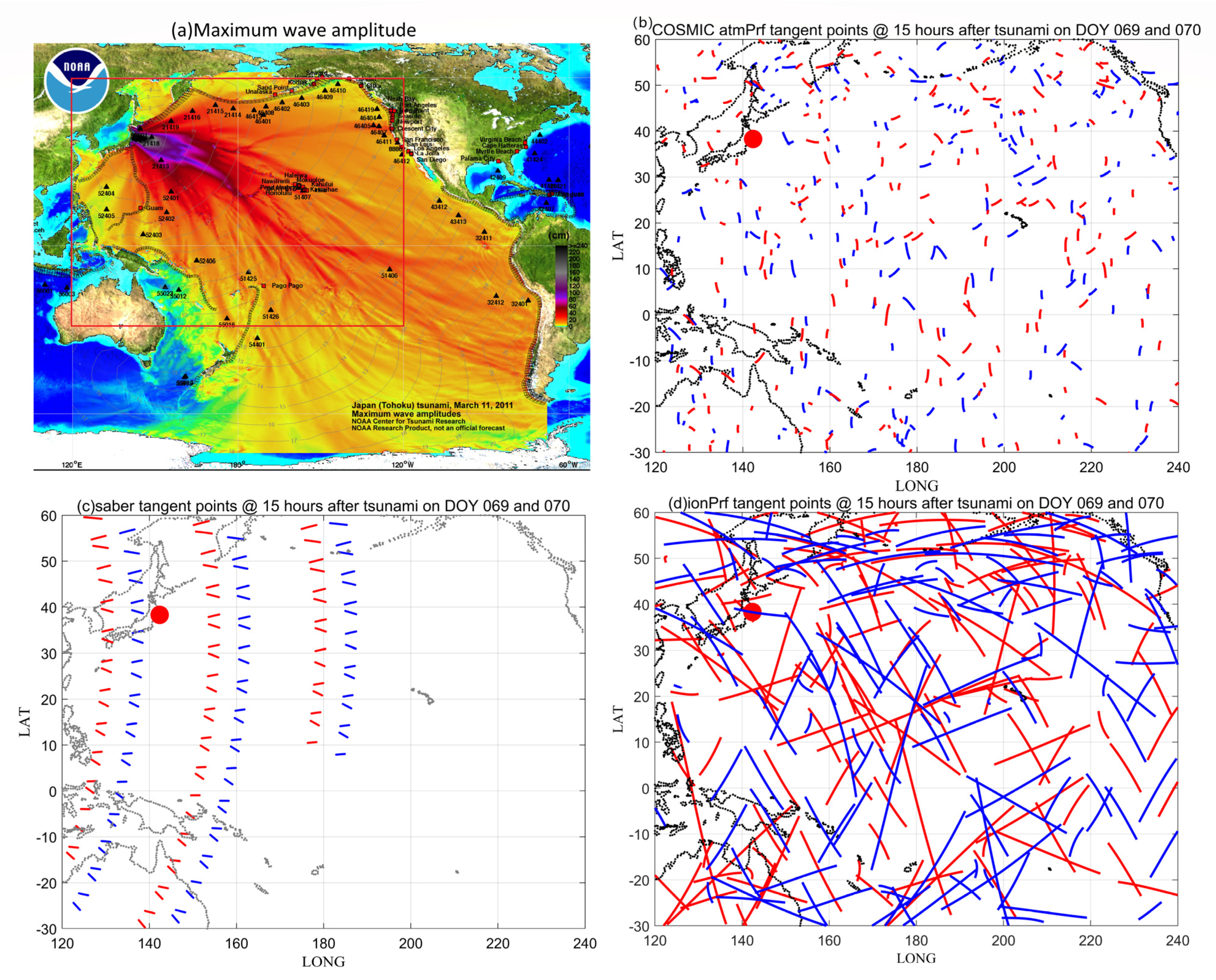
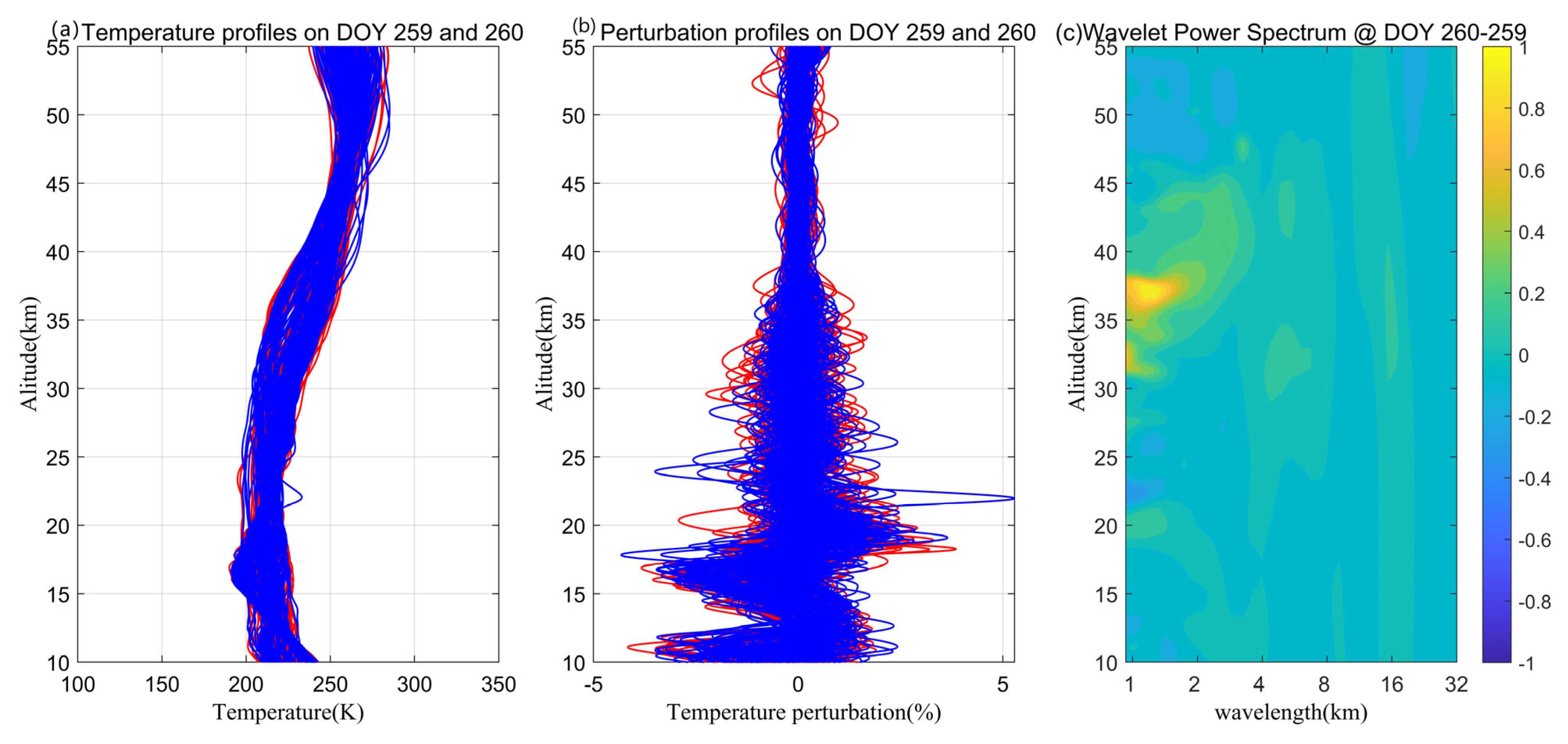
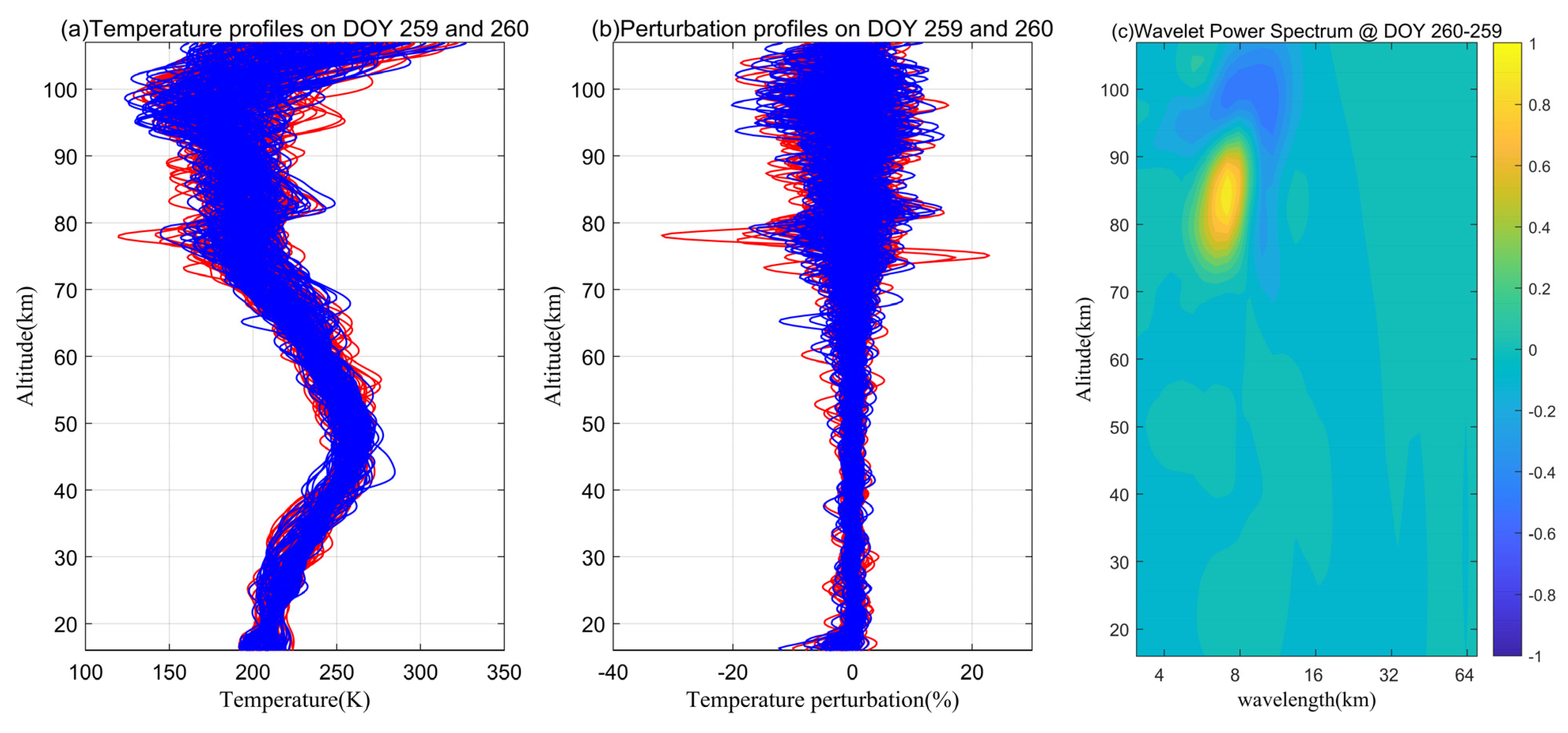
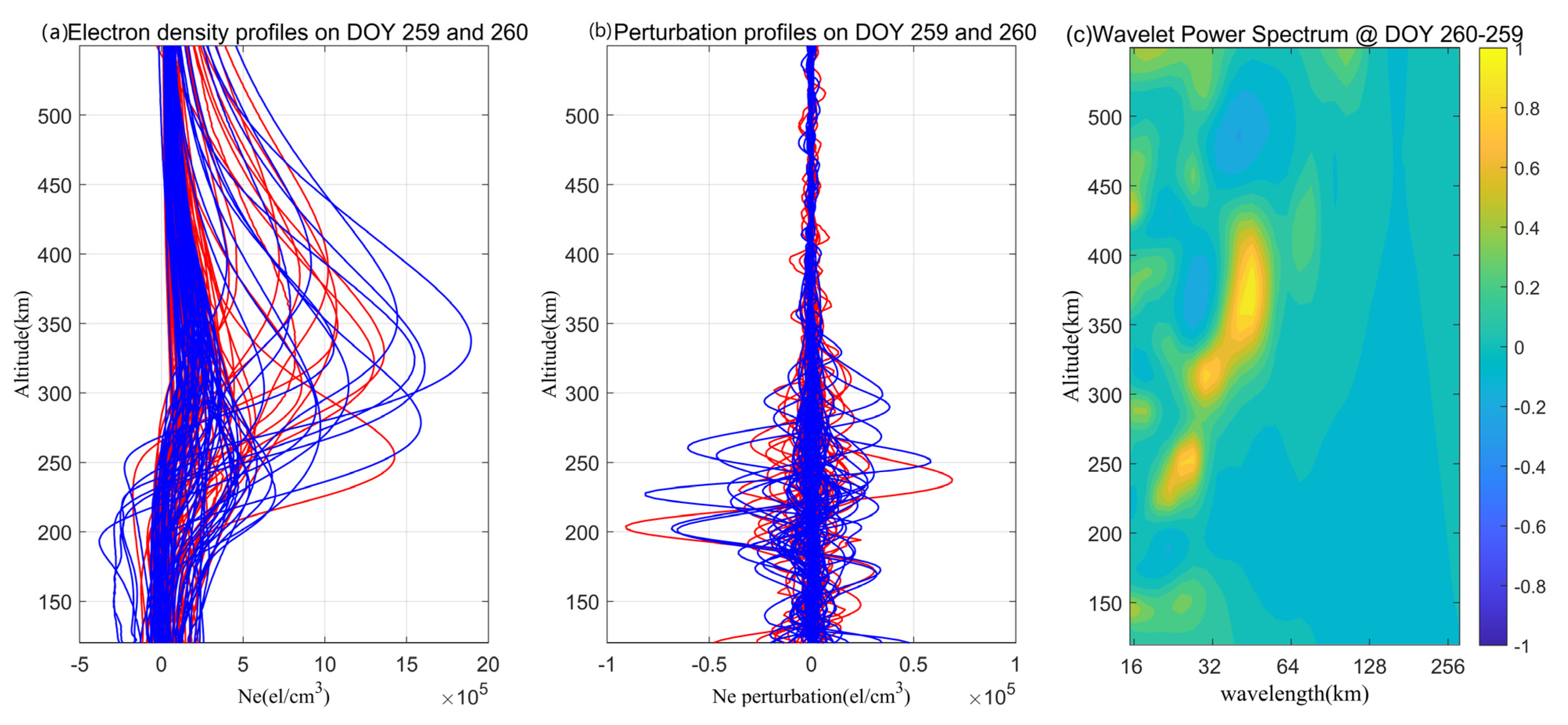
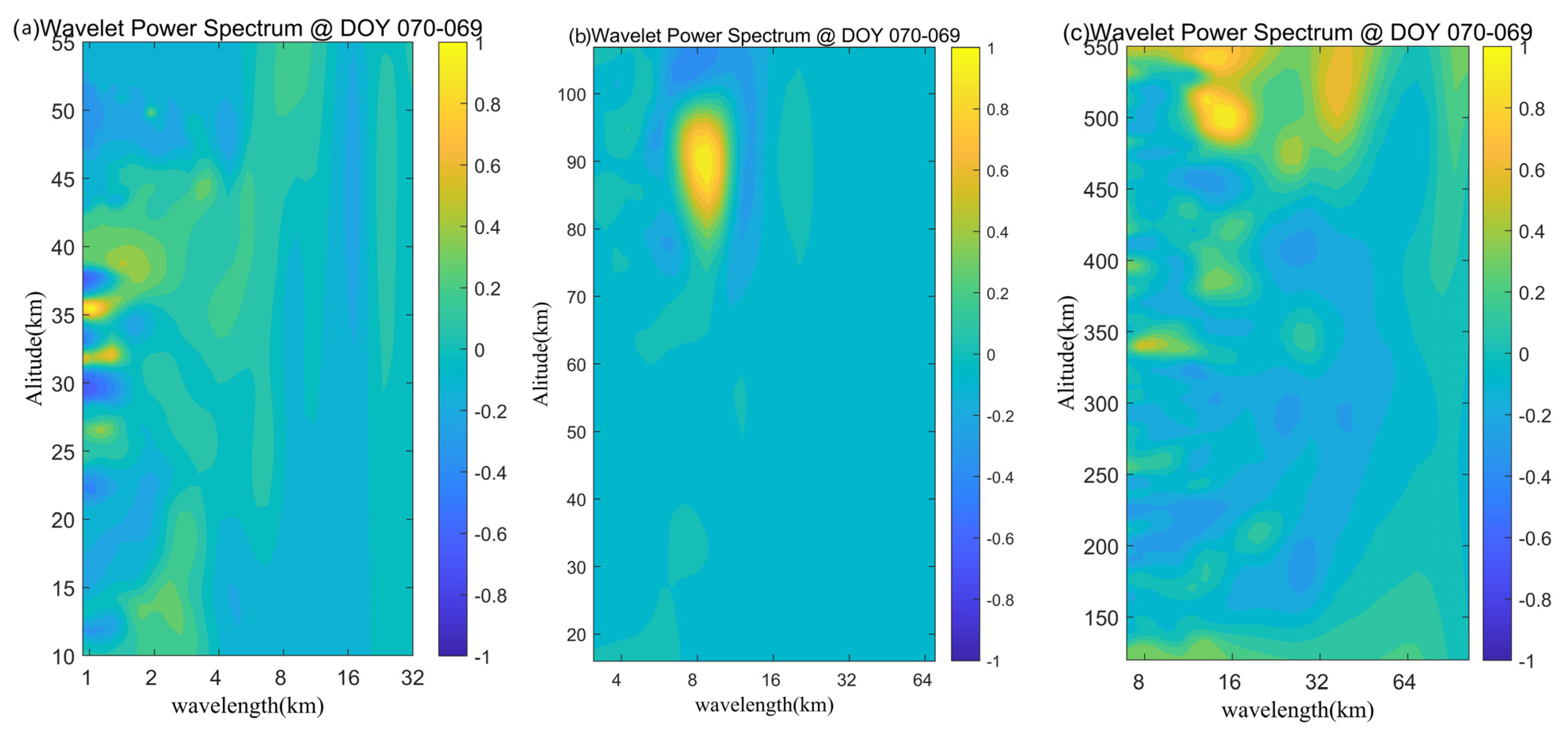
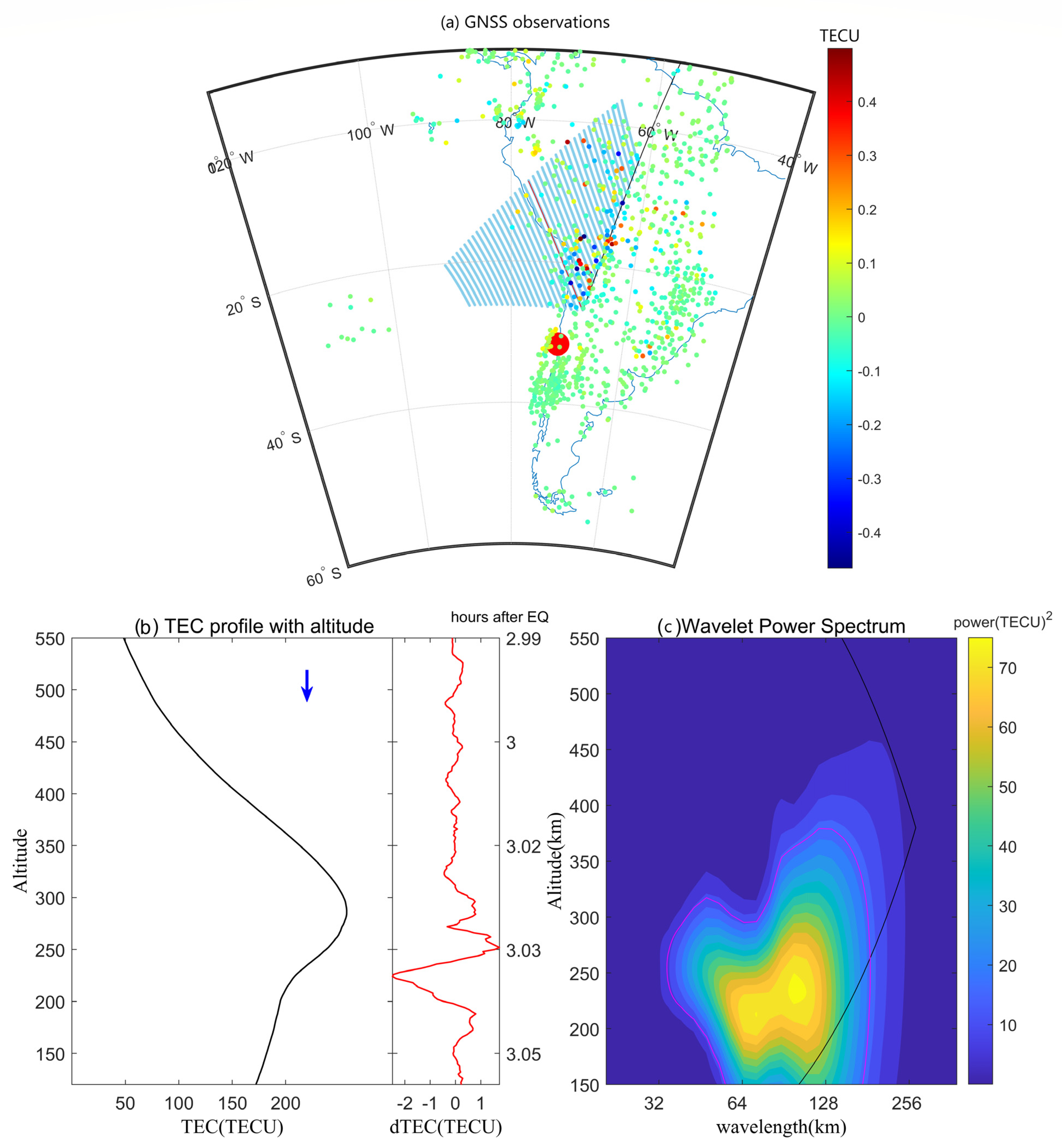
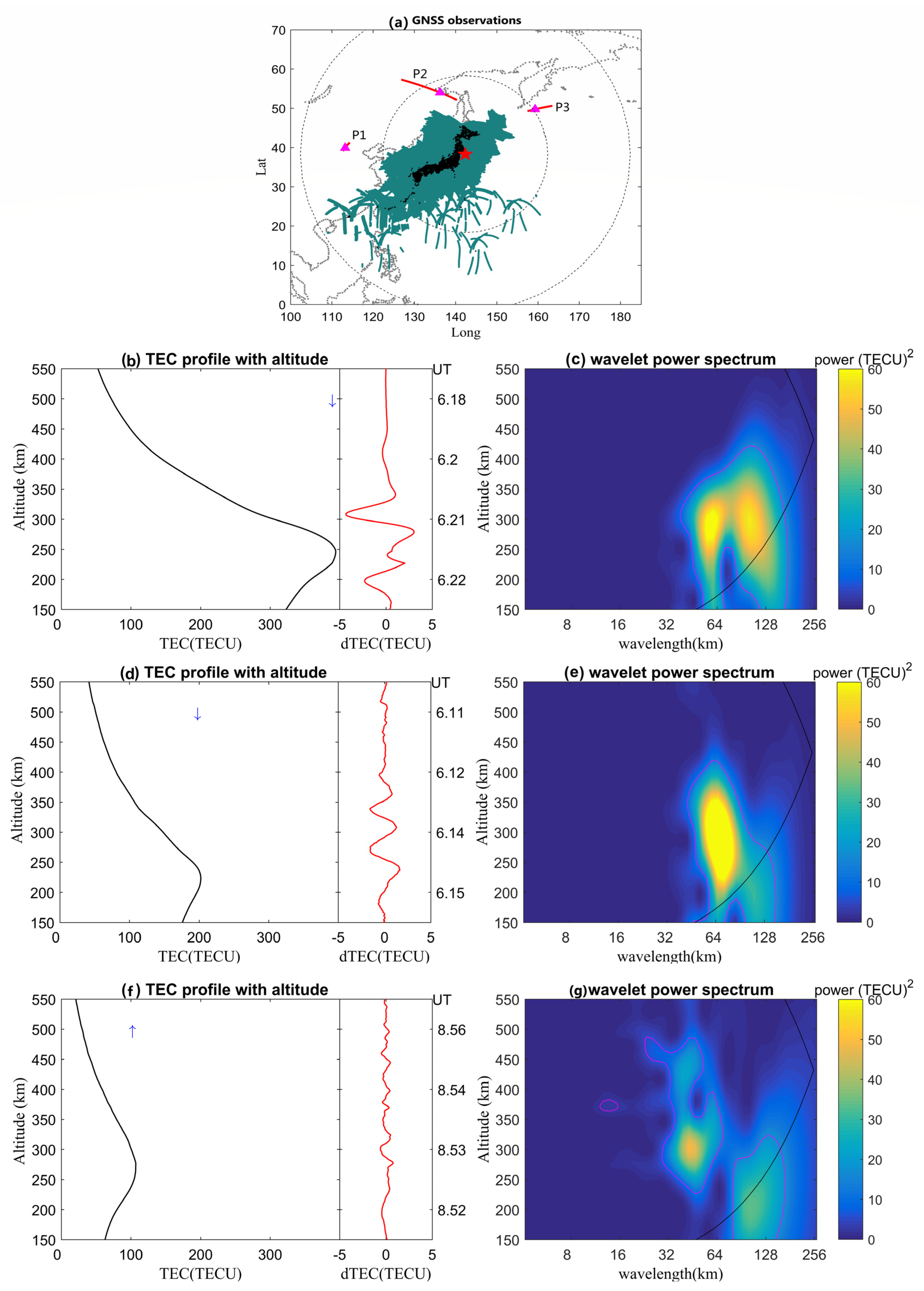
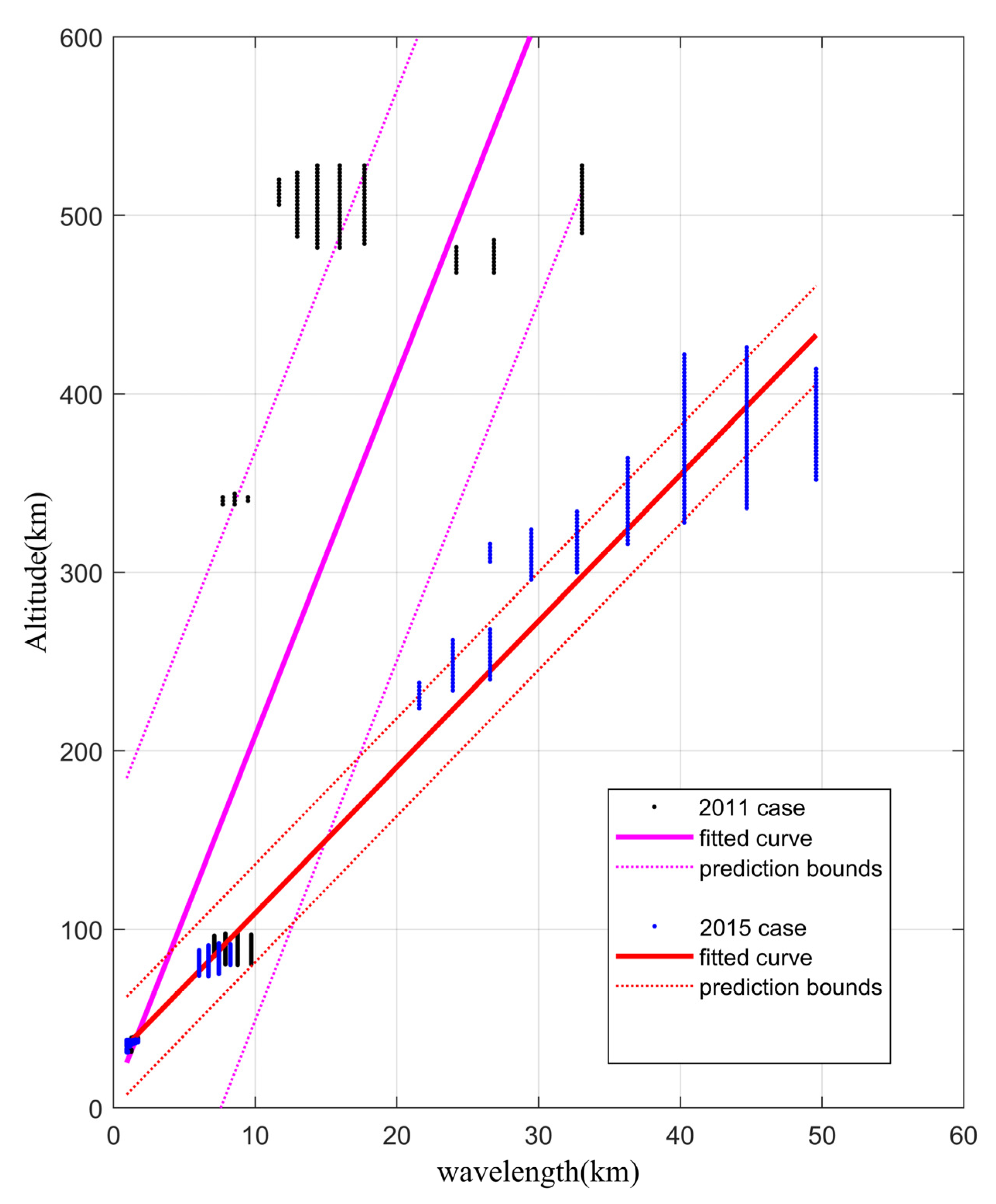
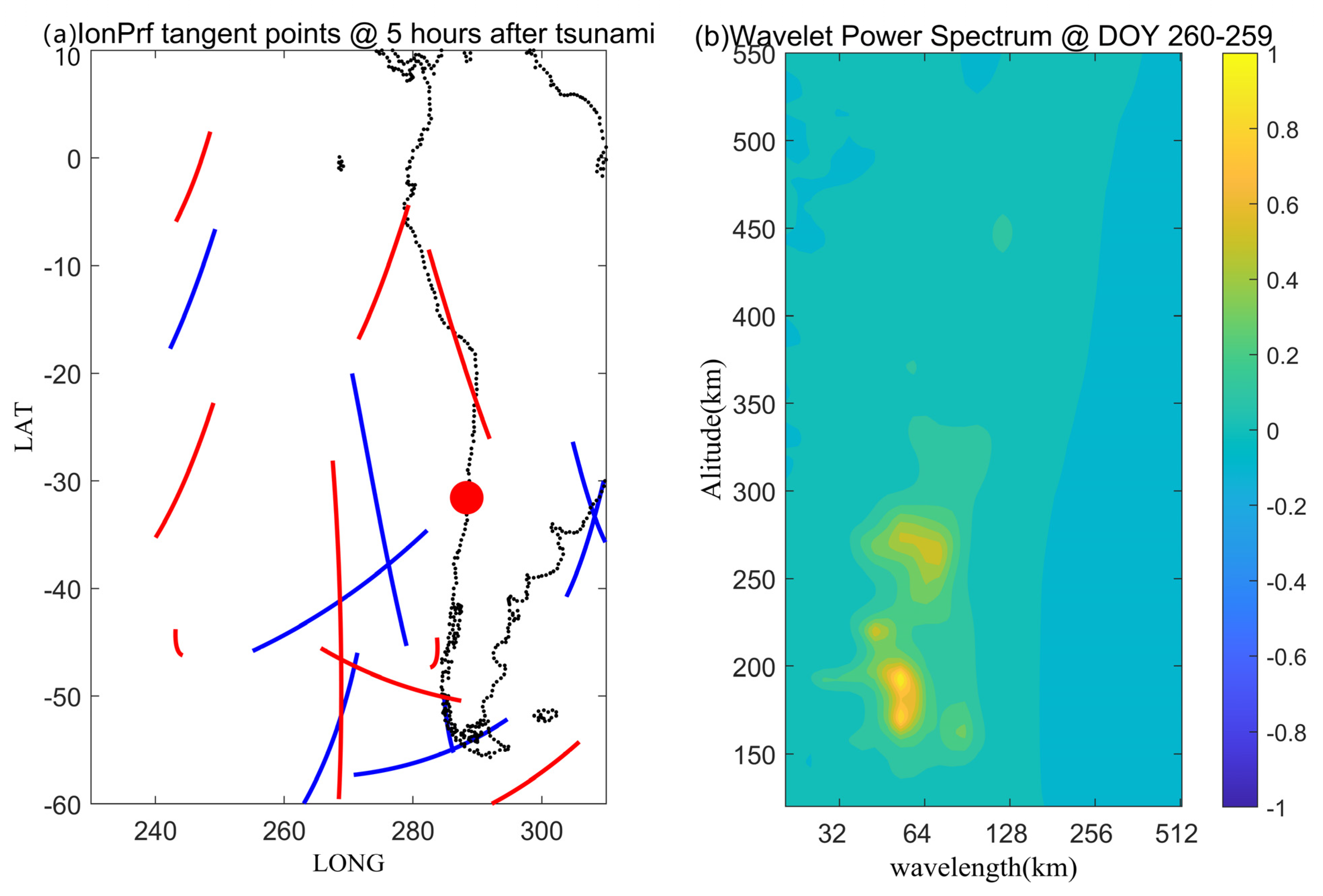
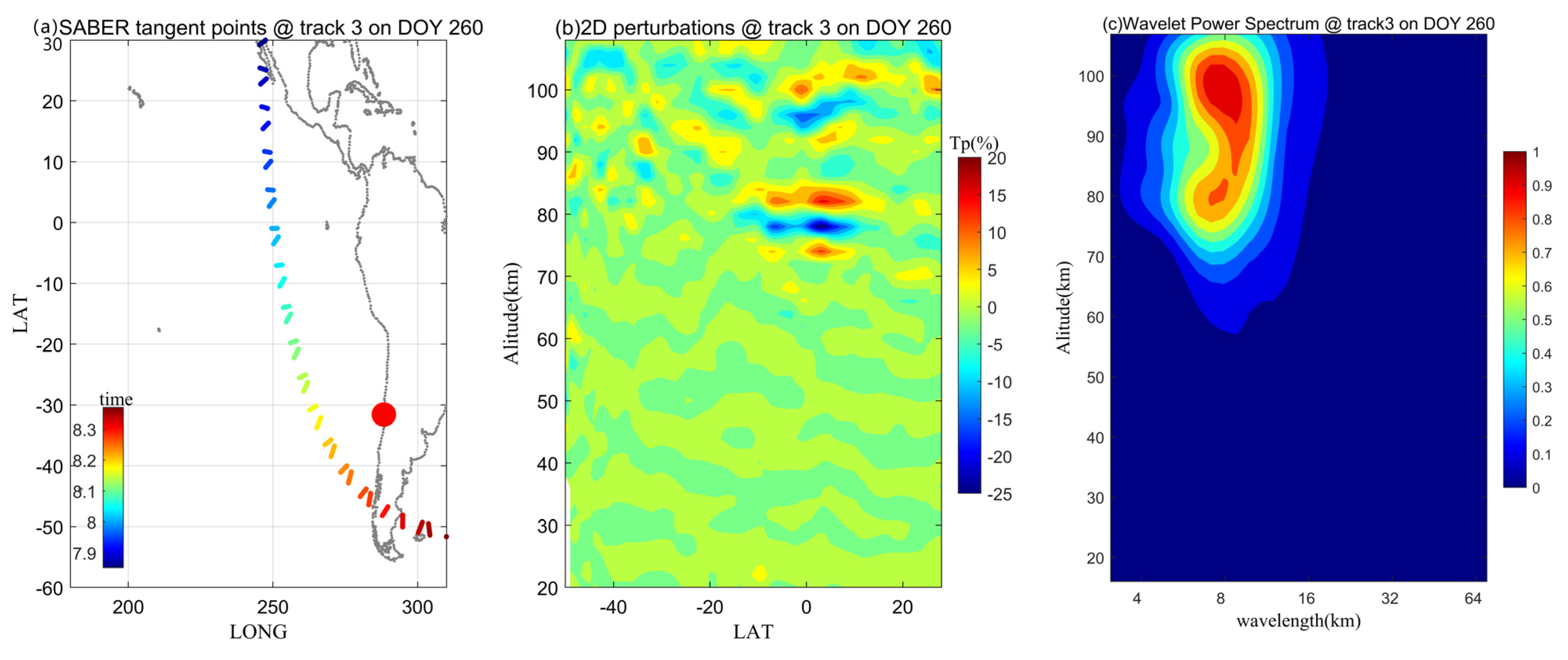
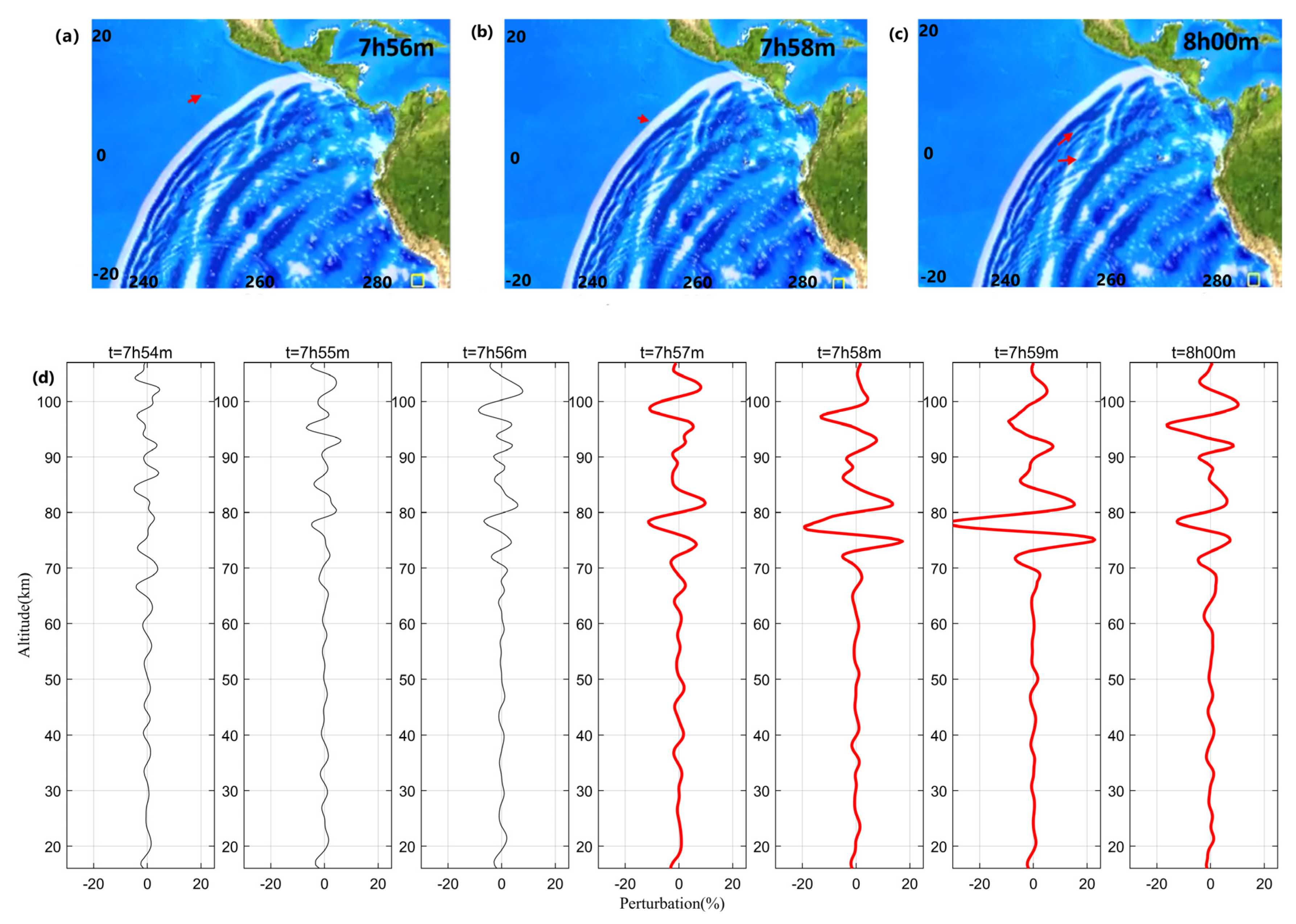
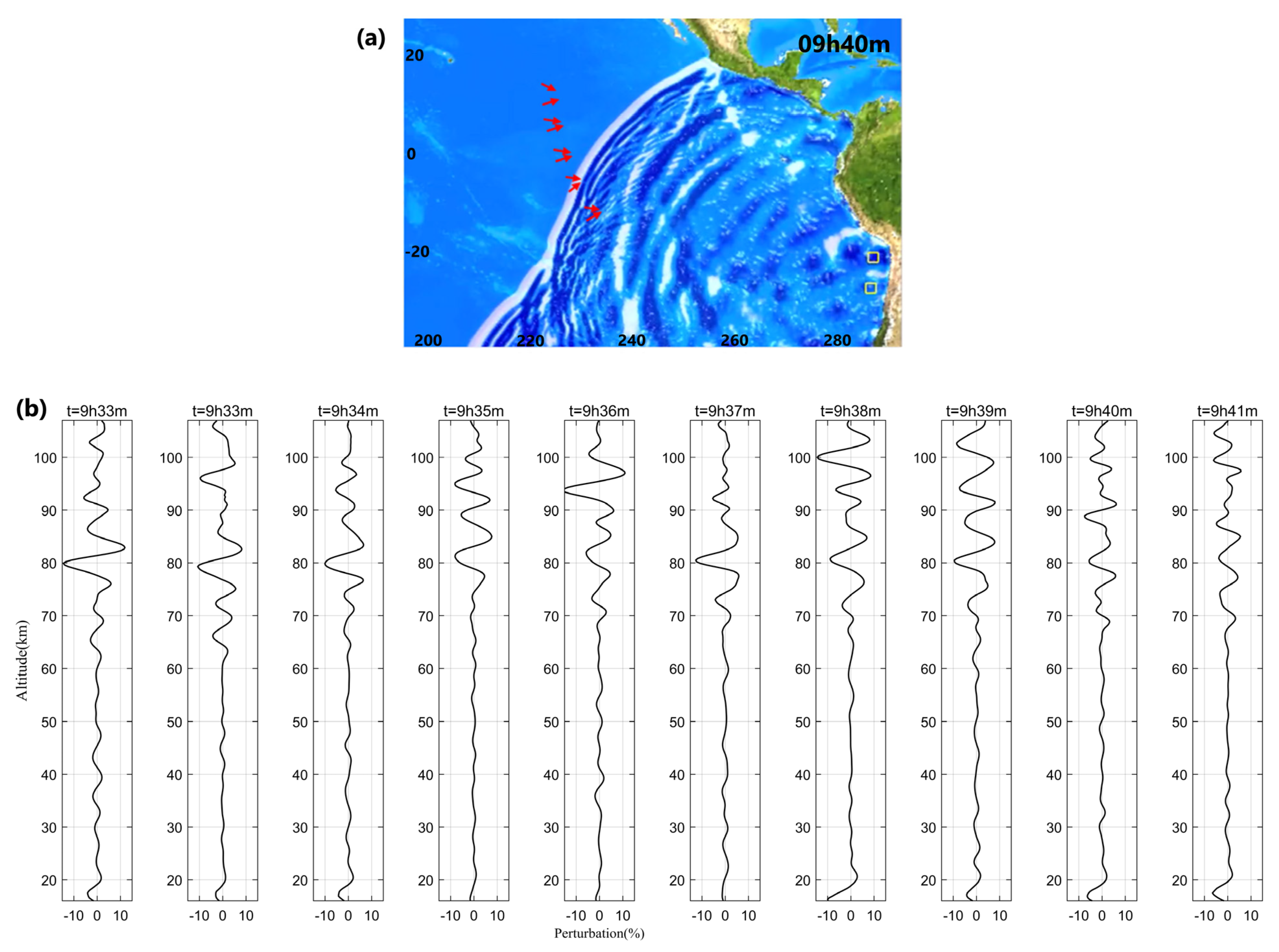
| atmPrf | SABER | ionPrf | ||||
|---|---|---|---|---|---|---|
| 10–55 km | 16–107 km | 120–550 km | ||||
| 16-09-2015 event | DOY 260 | DOY 259 | DOY 260 | DOY259 | DOY 260 | DOY 259 |
| 169 | 157 | 153 | 141 | 65 | 62 | |
| 11-03-2011 event | DOY 070 | DOY 069 | DOY 070 | DOY 069 | DOY 070 | DOY 069 |
| 208 | 194 | 66 | 69 | 141 | 130 | |
Publisher’s Note: MDPI stays neutral with regard to jurisdictional claims in published maps and institutional affiliations. |
© 2022 by the authors. Licensee MDPI, Basel, Switzerland. This article is an open access article distributed under the terms and conditions of the Creative Commons Attribution (CC BY) license (https://creativecommons.org/licenses/by/4.0/).
Share and Cite
Yan, X.; Yu, T.; Xia, C. Limb Sounders Tracking Tsunami-Induced Perturbations from the Stratosphere to the Ionosphere. Remote Sens. 2022, 14, 5543. https://doi.org/10.3390/rs14215543
Yan X, Yu T, Xia C. Limb Sounders Tracking Tsunami-Induced Perturbations from the Stratosphere to the Ionosphere. Remote Sensing. 2022; 14(21):5543. https://doi.org/10.3390/rs14215543
Chicago/Turabian StyleYan, Xiangxiang, Tao Yu, and Chunliang Xia. 2022. "Limb Sounders Tracking Tsunami-Induced Perturbations from the Stratosphere to the Ionosphere" Remote Sensing 14, no. 21: 5543. https://doi.org/10.3390/rs14215543
APA StyleYan, X., Yu, T., & Xia, C. (2022). Limb Sounders Tracking Tsunami-Induced Perturbations from the Stratosphere to the Ionosphere. Remote Sensing, 14(21), 5543. https://doi.org/10.3390/rs14215543





